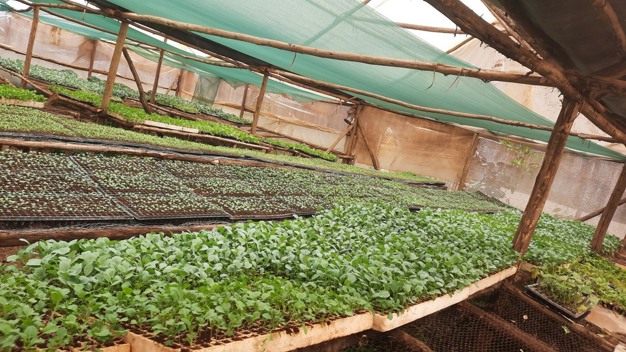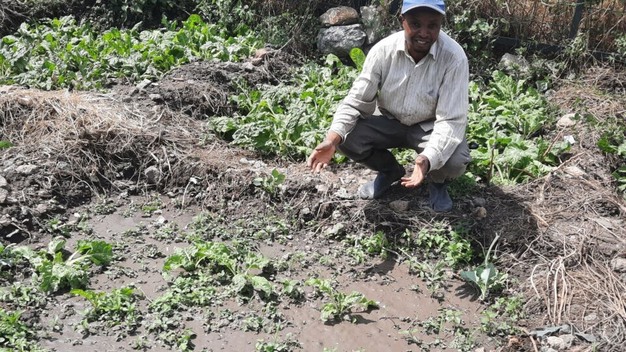Many farmers make the mistake of sowing all their seeds outdoors, under full sunlight and directly on the ground. If the seeds are not suitable for this kind of sowing method, there is a danger of such seeds getting washed away, blown away by the wind, getting buried under the soil and not germinating at all. It is because of this that farmers across the country are moving from the traditional ways of growing their seedlings to the most convenient and reliable methods. One such type is the use of trays in growing seedlings before transplanting them to the farm, a method that has proved to be efficient. Seedling trays or seed trays are made up of foldable plastic material. There are cells (holes) throughout the trays, which should be filled with sowing medium, such as soil, cocopeat or sand. Depending on the type of plants, two to three seeds are sown in each cell. Trays are watered regularly as the seeds germinate.

Young seedlings can be kept in these trays safely for three to four weeks under semishade until they are ready to be transplanted on the field or in bigger containers. Stephen Oloo, an assistant at JK Farm in Thika, Kiambu County says the use of seedlings trays ensures 98 per cent germination of the seeds they plant. One of the advantages of using this tray system is that they can be recycled several times, and the positive outcome is still guaranteed. “For this system, we use cocopeat in place of soil. Cocopeat is a fiber made out of coconut husks (coconut shell), which once extracted, it becomes a natural growing medium for plantation,” says Oloo. And since the coconut originates from a salty environment in the Coast region, the cocopeat needs cleaning off of the saltiness in it and then dried up, before it is ready for usage in plantation of seeds. The cocopeat is then placed on the trays before the farmer plants the seeds, where it takes up between five and seven days before it germinates to a seedling. Depending on the type of plant, only one seed is planted in one hole while some, such as onions, which have weak stems require two or three seedlings in one hole.
“One thing about this system, one can monitor the number of seeds that will germinate, which is contrary to the traditional methods, such as use of nurseries where seeds are planted directly on the soil, which then makes it impossible to know the number of seeds that have sprouted from the soil. Also, with the tray system, it is almost 100 percent that the seed will germinate to seedlings,” he says. Also, the resources needed in growing the seedlings are limited compared to using land. The trays can be stacked up in an orderly manner, thereby taking up small spaces. Also, the water used in watering the trays is small compared to watering the normal nursery.
 Emmanuel Kamanda, a farmer along Mombasa Road shows soil seedlings destroyed by the rains. PHOTO: PD/Malemba Mkongo
Emmanuel Kamanda, a farmer along Mombasa Road shows soil seedlings destroyed by the rains. PHOTO: PD/Malemba Mkongo
This system is, especially efficient for commercial seed propagators who will be able to maximise the available resources. “With the limited space that we have, we are able to grow several types of seedlings and in large volumes. This system allows us to use whatever space we have to propagate the seeds,” he notes. And while the propagators are already witnessing the benefits of this system, farmers are also anticipating better yields from crops planted from tray seedlings.
Emmanuel Kamanda, a farmer along Mombasa Road says the difference between crops from soil seedlings and those from tray seedlings are significantly visible. Kamanda says the tray seedlings tend to produce more yields compared to soil seedlings, since close to 98 per cent of the transplanted tray seedlings are likely to survive compared to the seedlings taken from the soil. “Seedlings from a tray have numerous roots compared to soil seedlings, which have one or two roots. With many roots, chances of seedling picking up and growing are mostly assured. Aside from the roots, the tray seedlings are uprooted with its base soil, making it easy to plant and grow as it has its original nutrients,” he says.
Kamanda says the survival rates of tray seedlings are high as they are strong, and free from diseases or pests, since they are grown in a greenhouse, which is a confined environment, while the traditional nurseries in the farm give room for pests and diseases since they are propagated in open spaces and direct to the sun. Also, the quality of the yield is better for tray seedling crops compared to seedlings propagated directly on the soil because they tend to have strong stems, which can withstand any weather, especially wind, which makes it unlikely to suffer any damages. And while the piloting phase comes to an end and the project goes into fully implementation, more farmers, including schools are also adopting the innovation in a bid to improve their food production. The tray seedling propagation project, which is spearheaded by the Consortium of International Agricultural Center (CGIAR) in partnership with International Institute of Tropical Agriculture (IITA) under the Resilient Cities research initiative, seeks to harness the dynamism of urban societies and economies to catalyse technological, institutional, and social change. By enabling agrifood system innovations and investment strategies for inclusive job and business opportunities, the initiative aims to ensure access to healthier diets for all, safeguard human health, and minimise environmental risks. The initiative generates evidence, technologies, and capacities that help improve urban food systems and secure equitable job and business opportunities, healthy diets for all, human and environmental health, and a reduced carbon footprint.
Source: cgiar.org
